|
|
JAMES BOND
|
|
|
JAMES BOND
|
|
|||||||||||||||||||||||||||||||||||||||||||||||||
|
|||||||||||||||||||||||||||||||||||||||||||||||||
|
Part Five: The ‘Still-Life’ series 1972-1977 Although GOLDFINGER was out-of-print throughout 1971, there was clearly enough interest in the title to prompt PAN Books to republish the novel again in paperback from the 22nd edition in 1972. Rather than reprint the ‘white-model’ edition last published in 1969, PAN used GOLDFINGER to launch another series with a new set of striking covers. Although no designer is credited with the ‘still-life’ covers, it is very likely that all titles were created at the same time and then released as stocks of the ‘white-model’ series eventually sold out. That series had some of the smallest print-runs of any title, and overall sales had dropped dramatically during the life-cycle of those covers. Total sales of the Bond titles had fallen from an all-time high of 6.8-million copies sold in the UK in 1965, to only 258,000 in 1971 - the lowest number since 1959. Sales were clearly boosted by the release of each new film, and with the return of Sean Connery to the role of James Bond in 1971; it is no surprise that DIAMONDS ARE FOREVER was the biggest-selling title in its film tie-in edition in 1972. |
|||||||||||||||||||||||||||||||||||||||||||||||||
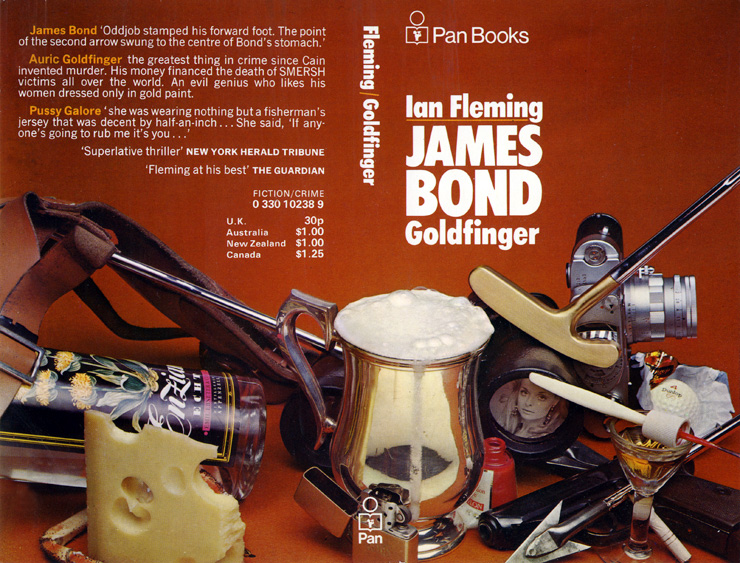 |
|||||||||||||||||||||||||||||||||||||||||||||||||
|
The wrap-around covers for each of the new titles all feature a black & white photograph of one of the female characters in the novel, surrounded by objects described by Ian Fleming in the story. GOLDFINGER has the photograph inserted into the lens of a pair of binoculars, so this could be said to represent Jill Masterton as she helps Goldfinger cheat at Canasta in chapter four. The cover also includes a gold-plated golf club and Dunlop 65 golf ball used by the eponymous villain in chapter eight; a silver tankard of pink champagne, and almost hidden by a piece of gorgonzola cheese on the back cover, is a crab claw. The last three items are described by the author as part of a meal Bond enjoys with Mr. Du Pont in chapter two. Du Pont's plain gold Zippo lighter can also be seen behind the PAN logo on the spine of the paperback. Jill Masterton's Revlon nail polish and a Leica camera are also mentioned in chapter four. The PAN designers have gone to great lengths to find the exact branded items the author describes, even down to the bottle of Enzian Schnapps Bond drinks in chapter 14. One of Bond's three-banded Morland cigarettes can also be seen beside his Walther PPK, underneath a steel arrow used by Oddjob when he captures Bond and Tilly Masterton in the same chapter. |
|||||||||||||||||||||||||||||||||||||||||||||||||
|
|||||||||||||||||||||||||||||||||||||||||||||||||
|
GOLDFINGER sold 41,000 copies of the new cover in 1972, the highest annual total since 1966. The title was joined in the first wave released on July 14, 1972 by CASINO ROYALE, THUNDERBALL, YOU ONLY LIVE TWICE, THE MAN WITH THE GOLDEN GUN and OCTOPUSSY. In September 1972 ON HER MAJESTY'S SECRET SERVICE was added to the series. Ian Fleming's first James Bond novel CASINO ROYALE had been continuously in print since 1955, but the last four titles were coming to the end of their print runs in previous editions, so were natural choices to be published first in the ‘still-life’ series. ON HER MAJESTY'S SECRET SERVICE and YOU ONLY LIVE TWICE had not been issued as part of the previous ‘white-model’ series, as the film tie-in editions were still in circulation at the time those covers were current. |
|||||||||||||||||||||||||||||||||||||||||||||||||
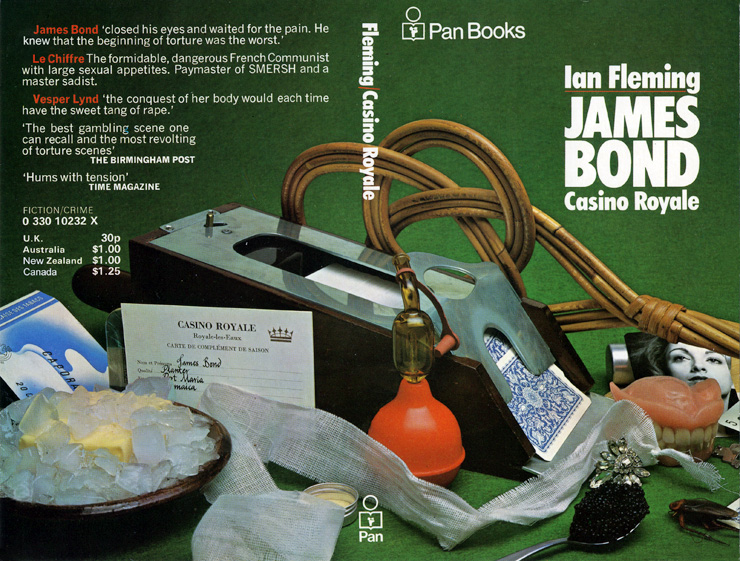 |
|||||||||||||||||||||||||||||||||||||||||||||||||
|
The CASINO ROYALE cover features Le Chiffre's Benzedrine inhaler and false teeth, a box of Gauloises Caporal cigarettes (smoked by Le Chiffre and Mathis in the novel), a playing card shoe and the bamboo carpet beater used to torture Bond are also visible. A thick square of deep yellow butter set in chips of ice is from the meal Bond shares with Vesper Lynd in chapter 24. A spoonful of caviar represents another meal from Chapter eight. Vesper's diamond clip can be seen beside a strip of bandage used to tie Bond's hands during his torture by Le Chiffre. James Bond's registration card from the Hotel Splendide is also shown on the back cover. A cockroach is also representative of the hotel where Bond and Vesper stay in chapter 22. All of the items are carefully arranged on the green baize of a casino table. CASINO ROYALE was reprinted four more times between 1973 and 1976. The final printing of 30,000 copies in June 1976 was the 33rd edition of Ian Fleming's first James Bond novel as a PAN paperback, and marked the highest number of times any of his novels had been printed. By the end of 1977 when PAN's sales records end, CASINO ROYALE had sold 2,371,000 copies in the UK. ON HER MAJESTY'S SECRET SERVICE not surprisingly features generic ski equipment and goggles, but the squeezed-out tube of Pepsodent toothpaste is exactly the brand used by Ruby in chapter 14. The German language daily newspaper is Züricher Zeitung, behind which one of Blofeld's henchmen hides in the helicopter taking Bond and Irma Bunt to Piz Gloria in chapter nine. The photograph representing Tracy inside a metal case also contains a bullet case foreshadowing her murder at the climax of the novel, in a similar way that the wedding ring and blood in the snow had on the Raymond Hawkey designed PAN paperback cover for ON HER MAJESTY'S SECRET SERVICE in 1964. A barely visible hunk of bread from the meal Bond eats before returning to Piz Gloria with Draco in chapter 24 can also be seen on the front cover. A Schmeisser submachine gun is the same model used by both Draco's men and the SPECTRE guards who try to stop Bond as he pursues Blofeld down the bob-run as he escapes from Piz Gloria in chapter 25. |
|||||||||||||||||||||||||||||||||||||||||||||||||
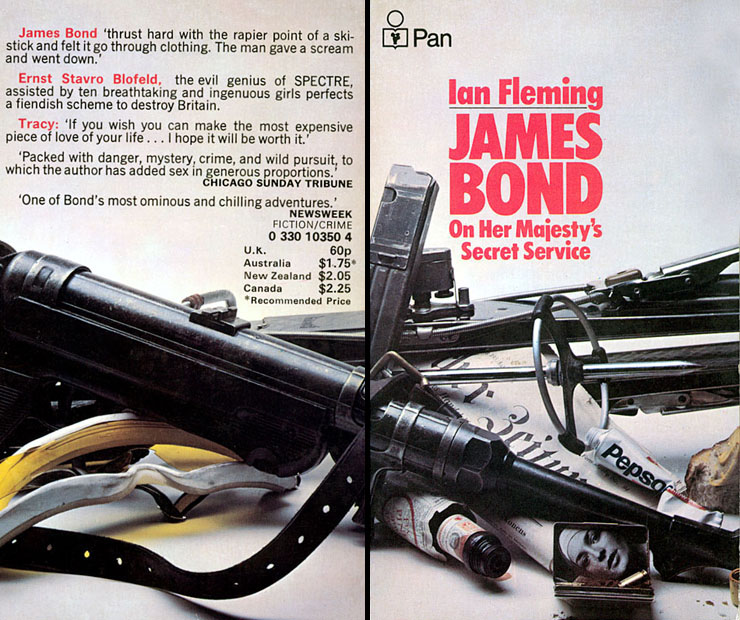 |
|||||||||||||||||||||||||||||||||||||||||||||||||
|
The OCTOPUSSY cover features objects from all three short stories contained in the anthology - a sniper's rifle from THE LIVING DAYLIGHTS, actual octopus tentacles representing the sea creature of the title story, and a Sotheby's catalogue and auctioneer's wooden gavel from THE PROPERTY OF A LADY. Presumably the girl in the photograph housed in the lens of a pair of pince-nez is meant to depict Maria Freudenstein, as the spectacles were worn by Dr. Fanshawe in that story. The photograph is of model/actress and fashion designer Edina Ronay, who is the daughter of famed food critic Egon Ronay. The gold Parker fountain pen is mentioned in the title story, with the herring and onion rings eaten by Bond in THE LIVING DAYLIGHTS. The tranquillizers are also mentioned in that short story, with the ammunition box and smoked sausage taken from OCTOPUSSY. |
|||||||||||||||||||||||||||||||||||||||||||||||||
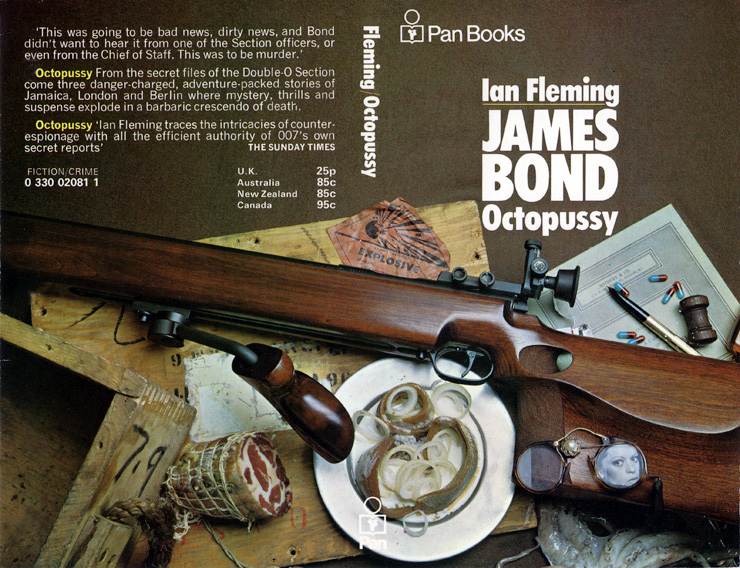 |
|||||||||||||||||||||||||||||||||||||||||||||||||
|
THUNDERBALL had not been issued as part of the ‘white-model’ series so the only copies in circulation at the time were the outdated film tie-in paperbacks. THE MAN WITH THE GOLDEN GUN had sold the last 4,000 ‘white-model’ copies by the end of 1971 which is why this title was part of the first wave, although it was superseded by its own film tie-in edition in 1974. Another factor for these titles being chosen first was the need to have covers with the new 30 pence price point, as all previous versions still existed with the old 3/6 or 20 pence price point. OCTOPUSSY was only printed once with the ‘white-model’ cover, and stocks were depleted by early 1972, explaining its inclusion in the first wave of ‘still-life’ paperbacks at the slightly cheaper price of 25 pence due to its shorter overall page-count. |
|||||||||||||||||||||||||||||||||||||||||||||||||
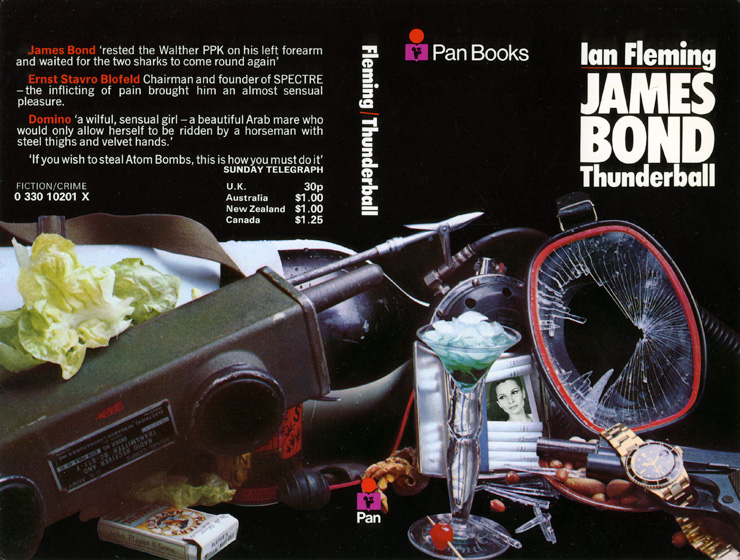 |
|||||||||||||||||||||||||||||||||||||||||||||||||
|
The initial print run of 45,000 copies of THUNDERBALL sold out by the end of 1972, and was the first of the ‘still-life’ covers to be reprinted again in January 1973, before any further titles were added to the series. The January 1973 issue was actually the 18th printing of the paperback, but was mis-numbered on the copyright page as the 17th, resulting in three editions actually existing with this number. The next two reprints which failed to correct the error were the 19th printing in 1974, which was labelled as the 16th; and the 20th printing was once more incorrectly labelled as the 17th. This was the final printing of THUNDERBALL from PAN Books in March 1976, by which time the retail price had doubled to 60 pence. There is therefore no ‘still-life’ edition of THUNDERBALL from 1973 with the correct 18th printing listed. A small black & white photograph of actress Suzanne Lloyd is used to represent Domino in a silver case containing Bond's three-banded Morland cigarettes. Even Emilio Largo's drink of choice - a crčme de menthe frappé with a maraschino cherry can be seen prominently on the front cover, along with Giuseppe Petacchi's solid gold Rolex Oyster Perpetual watch on a flexible gold bracelet. The packet of Player's cigarettes featuring Domino's ‘Cardboard Hero’ described in great detail in chapter 15 can be seen on the back cover underneath a US Army radio receiver. Barely visible behind the receiver is a tin of black treacle, mentioned briefly at the beginning of the novel when Bond stays at Shrublands Health Clinic. |
|||||||||||||||||||||||||||||||||||||||||||||||||
|
|
|||||||||||||||||||||||||||||||||||||||||||||||||
|
THE MAN WITH THE GOLDEN GUN also sold very well when published with the ‘still-life’ cover. The initial print run of 43,000 copies sold out by the end of the year, and a second printing of 20,000 copies were issued in February 1973, with a further 20,000 copies printed in October. THE MAN WITH THE GOLDEN GUN was issued twice more by PAN Books as a film tie-in edition in December 1974 and March 1976, making the ‘still-life’ edition one of the harder titles to find on the second-hand market as only 83,000 copies were produced. Among the objects photographed for the cover of THE MAN WITH THE GOLDEN GUN, were a bottle of Red Stripe beer mentioned several times in Chapter five, a snake skin representing the one Scaramanga eats in chapter 15, a large Stilton cheese (into which the Red Stripe metal bottle top has been pushed) as eaten by M in his lunch at Blade's Club in chapter three, Jamaican bank-notes and Scaramanga's golden gun and bullet (although in this instance not the .45 calibre Colt revolver he uses in the book and as illustrated on the Jonathan Cape hardback dust jacket). Scaramanga's silver Turnip pocket watch (mentioned in chapter 13) houses a photograph which presumably represents Mary Goodnight as the main female character in the novel. |
|||||||||||||||||||||||||||||||||||||||||||||||||
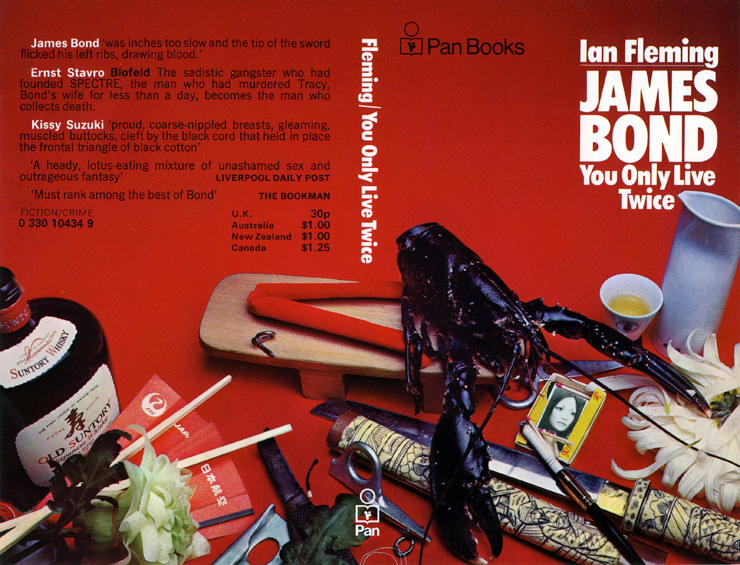 |
|||||||||||||||||||||||||||||||||||||||||||||||||
|
Among the objects on the YOU ONLY LIVE TWICE cover is a pair of scissors representing the ‘scissors-paper-stone’ game Bond plays with Tanaka in chapter three. The back-cover shows a bottle of Old Suntory whisky drunk with Dikko Henderson, a bowl of saké and a lobster from Bond's meal with Tiger Tanaka in chapter nine. Most of the objects on the cover are a direct reference to something mentioned in the novel, such as the Swan Vesta matches used by Sir James Molony in chapter two; but others are more oblique - are we to assume that the green leaf shown on the back cover is the poison oak mentioned in the list of specimens imported by Dr. Shatterhand, or is it meant to represent the Geisha ‘Trembling Leaf’? Also shown on the front cover is a white chrysanthemum blossom from Doctor Shatterhand's garden of death, which had also featured prominently on the cover of the Jonathan Cape hardback edition of YOU ONLY LIVE TWICE, in the trompe l'oeil painting by Richard Chopping. A Japan Air Lines ticket can also be seen on the back cover, underneath the pair of chopsticks Bond uses to eat raw octopus in his meal with Tiger Tanaka in chapter nine. Once again a printing error resulted in the January 1974 5th edition being incorrectly labelled as the 4th printing. |
|||||||||||||||||||||||||||||||||||||||||||||||||
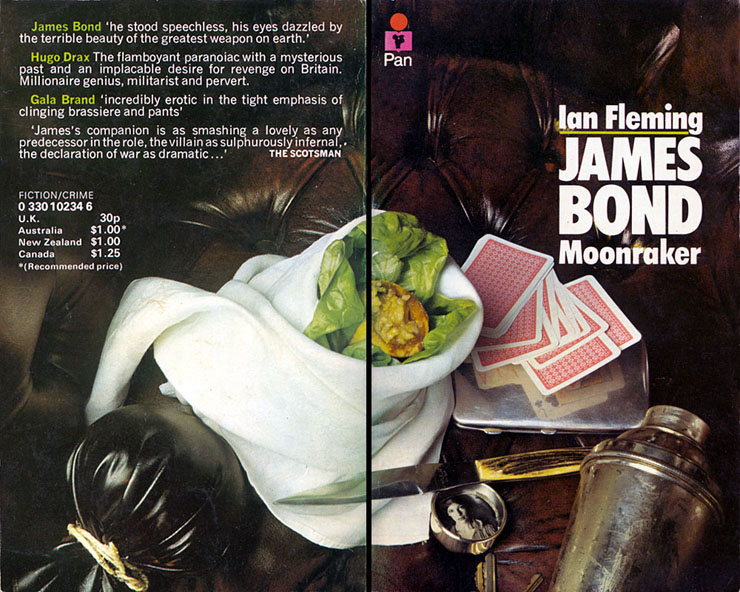 |
|||||||||||||||||||||||||||||||||||||||||||||||||
|
In March 1973 the next
three novels in the series were issued, each with an initial print-run of
30,000 copies. The MOONRAKER cover featured a collection of items arranged
in a leather armchair including a cocktail shaker, Drax's polished
metal cigarette case & playing cards, and a marrow bone placed upright in a
lace napkin exactly as described by Ian Fleming in the chapter ‘Dinner at
Blades’. Also visible are three items Bond removed from the body of Krebs
in chapter 15 - a bunch of skeleton keys, a spring knife with a
well-sharpened stiletto blade, and a black leather cosh. |
|||||||||||||||||||||||||||||||||||||||||||||||||
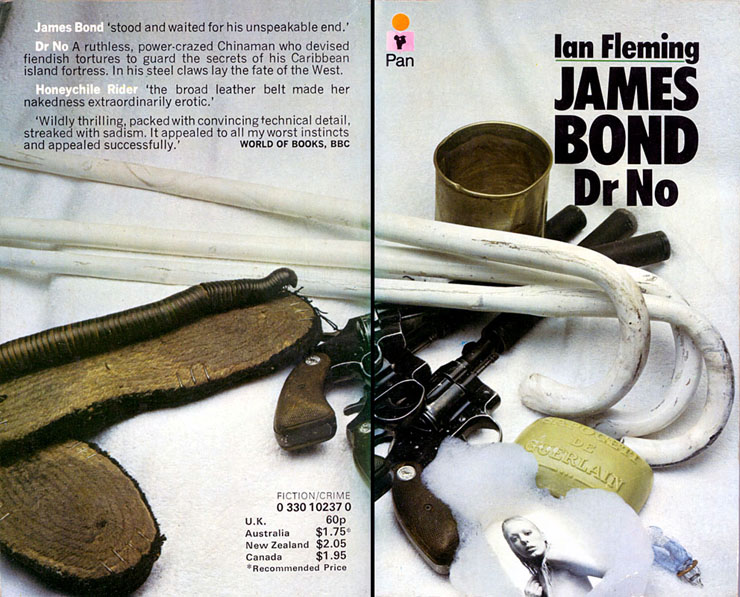 |
|||||||||||||||||||||||||||||||||||||||||||||||||
|
As with several other PAN paperbacks there was an numbering error starting with the 20th printing of DR. NO in December 1965 (with the Raymond Hawkey cover), which was incorrectly labelled as the 19th. This error was repeated for the next four editions, so the first ‘still-life’ cover was actually the 24th printing of the paperback, but incorrectly labelled as the 23rd. Order was restored in June 1975 with the second issue of the ‘still-life’' cover which was now correctly labelled as the 25th printing. A woven rug is the backdrop for Kerim Bey's silver dagger scabbard and various Turkish bank-notes on the FROM RUSSIA, WITH LOVE cover. A photograph of Tatiana Romanova is pierced by a wooden fork holding a piece of Turkish Delight beside a small cup of strong black coffee. |
|||||||||||||||||||||||||||||||||||||||||||||||||
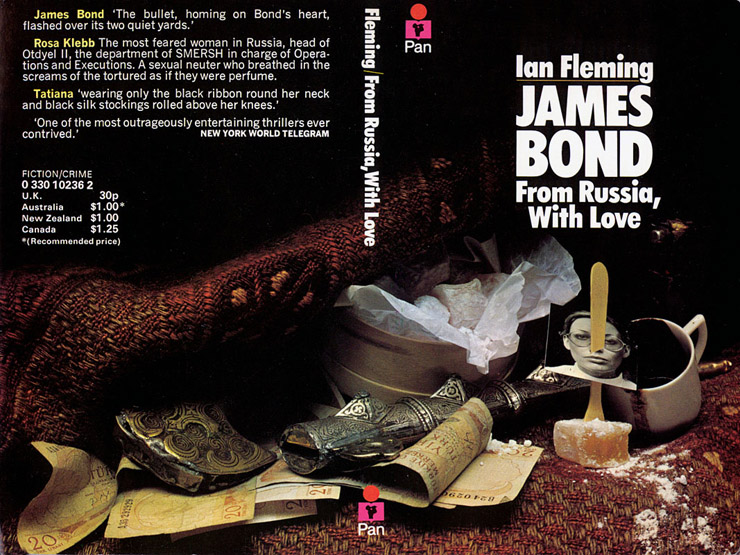 |
|||||||||||||||||||||||||||||||||||||||||||||||||
|
July 1973 saw THE SPY WHO LOVED ME and FOR YOUR EYES ONLY added to the series, each once again with an initial print run of 30,000 copies. A further 25,000 copies of THE SPY WHO LOVED ME were printed in November 1974, making this the hardest of the ‘still-life’ covers to find today, as only 55,000 were ever produced. The ‘white-model’ edition of THE SPY WHO LOVED ME was the last title issued in that series and had been printed for a second time in April 1972. Presumably copies of this edition were still in circulation in the early 1970s, so PAN waited for those to sell out before issuing the title with the ‘still-life’ cover. The last 500 copies of THE SPY WHO LOVED ME sold in 1976 and the novel was then out-of-print until 1980, when it appeared as the penultimate title issued in the Triad-Panther series. OCTOPUSSY and THE SPY WHO LOVED ME were the only Ian Fleming titles not to sell at least one-million copies as PAN paperbacks. |
|||||||||||||||||||||||||||||||||||||||||||||||||
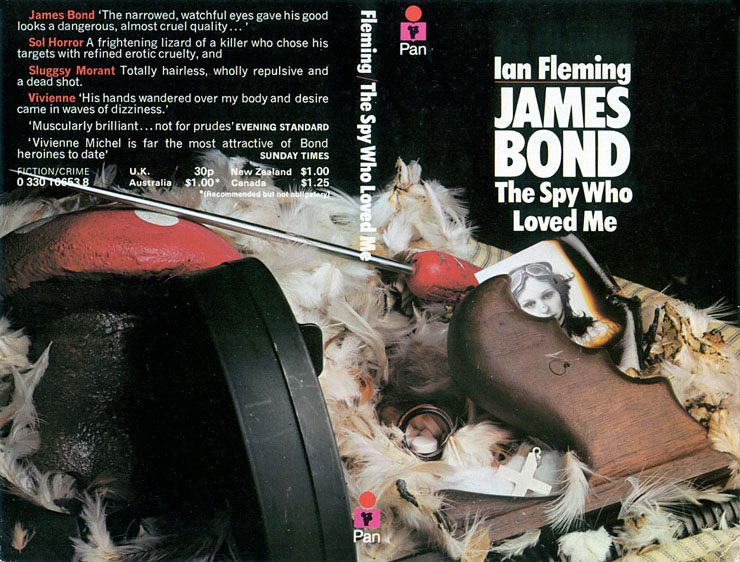 |
|||||||||||||||||||||||||||||||||||||||||||||||||
|
The cover of the ‘still-life’ edition of THE SPY WHO LOVED ME features a Tommy-gun, a red-handled ice-pick and a burnt photograph of Vivien Michel. A barely visible bottle of sleeping pills and gold cross are also placed amongst the feathers of a shot-through pillow. Perhaps the most obscure item is the concrete toadstool on the back cover, which is mentioned only once in the novel at the end of chapter six. The FOR YOUR EYES ONLY cover included items from several of the short stories in the anthology such as the camouflage jacket, motorcycle goggles and helmet featured in FROM A VIEW TO A KILL, and melon and prosciutto ham from Bond's meal with Kristatos in RISICO. The un-spooled tape used to record Colombo and Lisl Baum's conversation is from the same story. The black & white photograph is of Mary Ann Russell from the opening story, and a single red rose cleverly represents the fake one which enables Bond to discover the underground headquarters of SHAPE also mentioned in FROM A VIEW TO A KILL. |
|||||||||||||||||||||||||||||||||||||||||||||||||
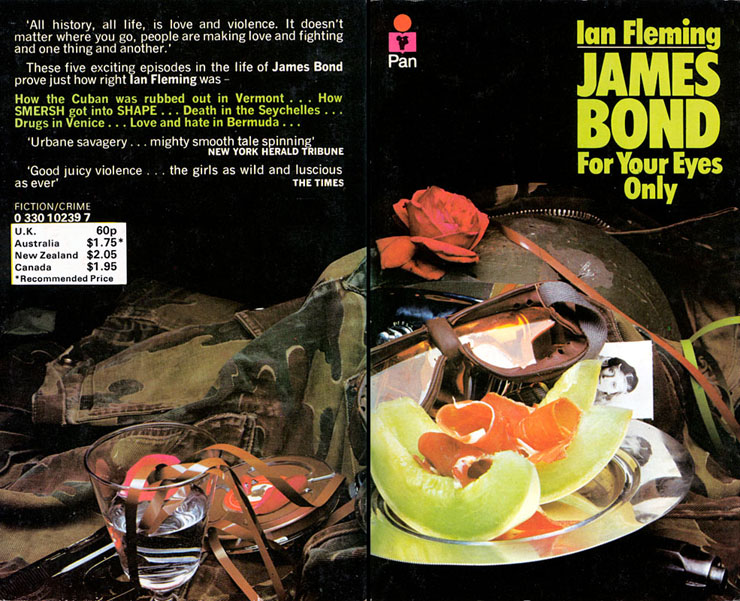 |
|||||||||||||||||||||||||||||||||||||||||||||||||
|
DIAMONDS ARE FOREVER was the last title to be published in the ‘still-life’ series. The film tie-in edition was then still in circulation and had sold over 150,000 copies during its three printings with the Robert McGinnis poster artwork cover. With the release of Roger Moore's debut film in 1973, sales of DIAMONDS ARE FOREVER dropped back to only 15,000 copies that year, the lowest number sold of any of the Bond titles. The LIVE AND LET DIE film tie-in sold a staggering quarter-of-a-million copies in its three printings, boosting overall annual sales of PAN James Bond paperbacks to 550,000 - the highest turnover since 1968. The cover for DIAMONDS ARE FOREVER was no doubt photographed at the same time as all the others but held back until required. Not surprisingly the cover features diamonds in tissue-paper and a hollowed-out golf ball (used to smuggle them into the USA in chapter seven of the novel), various dental instruments and bullets. The scorpion mentioned in the opening lines of the novel can be seen on top of the black & white photograph representing Tiffany Case. The items are scattered across the red leather of M’s desk exactly as described by Ian Fleming in chapter two of DIAMONDS ARE FOREVER. |
|||||||||||||||||||||||||||||||||||||||||||||||||
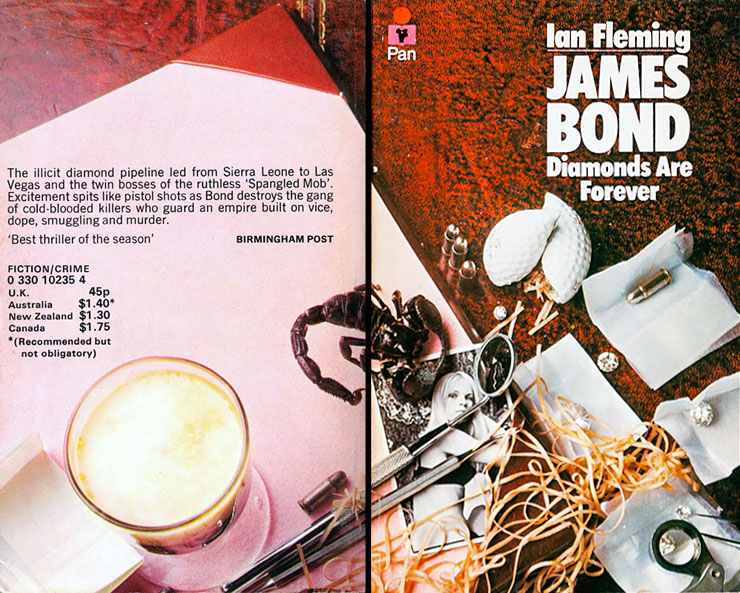 |
|||||||||||||||||||||||||||||||||||||||||||||||||
|
As with the 1960s Raymond Hawkey series, titles were not published in the same sequence as the novels were originally issued, and new ‘still-life’ covers were only released when stocks of existing paperbacks had been exhausted. With no frame of reference as a collector in the early 1970s this writer searched in vain for a ‘still-life’ edition of LIVE AND LET DIE, not realising that one was never issued. These ‘still-life’ editions were available at the time I first began to read the James Bond novels, and it was this series of covers above any other that captured my imagination as a teenager. At the time I began reading the James Bond novels in the early 1970s, the only way of knowing what other titles were available was from the bibliography printed inside each paperback listing the author's other work. I also searched for the ‘still-life’ edition of DIAMONDS ARE FOREVER, totally oblivious to the fact it was not issued until 1974, when stocks of the film tie-in had run out, and Roger Moore was then the current screen Bond. It was not until the late 1970s/early 1980s when I scoured second-hand bookshops and book fairs that I became aware that the ‘still-life’ series was incomplete, and that the 1960s Raymond Hawkey series was the only one issued by PAN Books where every Ian Fleming title was available with matching covers. It is very likely that a ‘still-life’ cover was created for LIVE AND LET DIE at the same time the rest were designed and photographed, but ended up not being used and a film tie-in edition published instead. Given that LIVE AND LET DIE was out-of-print throughout 1972, it is unusual that a new paperback was not issued as part of the initial batch of titles in the ‘still-life’ series. Interest in LIVE AND LET DIE would be heightened with the upcoming production of Roger Moore's debut film as James Bond, the title of which had been announced at the end of Diamonds Are Forever (1971). |
|||||||||||||||||||||||||||||||||||||||||||||||||
|
|||||||||||||||||||||||||||||||||||||||||||||||||
|
|
|||||||||||||||||||||||||||||||||||||||||||||||||
|
PAN Books reprinted all of the ‘still-life’ covers several times during their 1972-1976 life-cycle, with most stock running out by the end of 1977, when their rights to publish the James Bond novels in paperback came to an end. With their meticulously researched covers, these stylish and colourful editions have now become collectors’ items on the second-hand market. It is only now with hindsight that one can look back at the covers together in context to tell the full story of James Bond and PAN paperbacks. Other publishers have issued the James Bond novels with varying degrees of artistic and commercial success, but it is the PAN paperbacks which sold in huge numbers, with an astonishing 27,863,500 copies sold in the UK alone from 1955-1977. Their life-cycle coincided with the release of some of the most successful films in the EON series, so it is hardly surprising that GOLDFINGER and THUNDERBALL were the best-selling titles overall, boosted by the phenomenally successful film tie-in editions, which in turn generated further interest in Ian Fleming's other novels. The release of Live And Let Die in 1973 also resulted in huge sales of Fleming's source novel. Although not published in paperback until 1966, after the ‘Bondmania’ boom set record-breaking paperback sales, THE MAN WITH THE GOLDEN GUN had one last successful year in 1975 on the back of the release of Roger Moore's second James Bond film. Although overall sales had dropped to a low of 156,000 for all titles in 1977, the least number sold since 1958 (when only four titles were available in paperback) interest in the novels was kept alive, and it is clear there was a direct link between the annual paperback sales and release of each new film. The table below shows the sales in Britain of Ian Fleming's James Bond novels as PAN paperbacks from 1955-1977, and it is clear to see that the biggest-selling titles were those which had a similarly successful film adaptation, which therefore boosted the sales of that source novel. GOLDFINGER and THUNDERBALL not surprisingly sold the most number during the release of the two film versions at the height of ‘Bondmania’. There was clearly a direct correlation between the films and the novels in the mid-Sixties, and it is perhaps not a coincidence that the position of the W. H. Smith & Son Ltd. advertisement [pictured below] in the Newcastle Evening Chronicle in October 1964 was next to an advert block announcing the opening of Goldfinger at the ODEON Newcastle, where it played for an unprecedented six-weeks. LIVE AND LET DIE also sold nearly a quarter-of-a-million copies in 1973 alone, no doubt helped by the huge surprise Summer hit of Roger Moore's debut as James Bond. Ian Fleming's second James Bond novel was therefore the biggest-selling of any of the James Bond titles since 1968, when OCTOPUSSY was first published in paperback by PAN Books. CASINO ROYALE had always been a big seller, and was the first James Bond novel to reach one-million sales in 1964. DIAMONDS ARE FOREVER was not far behind, and had two big-selling years in 1971/72 as a film tie-in edition from PAN Books. DR. NO continued to sell steadily after the release of the film version, but nowhere near as many copies as it had in 1964/65. With the exception of FOR YOUR EYES ONLY, the last titles were released after the ‘Bondmania’ boom in the mid-Sixties, which ended as quickly as it had begun. Once Sean Connery had announced his retirement from the role in 1966, overall sales of the PAN James Bond paperbacks fell by almost two-thirds, from 1.8-million sold in 1967, to just 659,000 in 1968. Although the release of each new film in the series until 1974 would boost annual sales figures, the number of paperbacks sold in the next decade was 3-million copies - almost half of what it had been at the height of their success from 1963-1965. James Bond's creator Ian Fleming died in August of 1964, and had only just begun to reap the rewards generated by the sales of his novels in PAN paperback. |
|||||||||||||||||||||||||||||||||||||||||||||||||
|
|||||||||||||||||||||||||||||||||||||||||||||||||
|
It has always been reported that the James Bond novels were never out-of-print since their first publication. However, closer inspection of PAN's sales records indicates this was not the case; MOONRAKER, GOLDFINGER, and LIVE AND LET DIE were out-of-print for at least a year, before being republished with a new cover which also no doubt boosted sales when they were available in bookshops again. PAN Books reprinted most titles in the ‘still-life’ series for a final time during 1976, in addition to a final printing of 20,000 copies of the film tie-in edition of THE MAN WITH THE GOLDEN GUN, which was still popular as the most recent film in the EON series. Only THE SPY WHO LOVED ME sold out completely at the end of 1976 and would remain out-of-print in the UK until 1980, by which time PAN had lost the paperback rights. Any unsold copies of titles in the ‘still-life’ series were remaindered by the publisher in March 1978 in an attempt to clear stock from bookstores, and make way for the new series from Triad/Panther. However, no other publisher would come close to achieving the phenomenal sales figures generated by their James Bond paperbacks, than PAN Books did in the 1960s. Now that PAN Books’ 22-year publishing history of the James Bond novels can been seen in context, collectors may want to re-think the order in which their own paperbacks are displayed on the bookshelf! |
|||||||||||||||||||||||||||||||||||||||||||||||||
|
|||||||||||||||||||||||||||||||||||||||||||||||||
|
|||||||||||||||||||||||||||||||||||||||||||||||||
|
|||||||||||||||||||||||||||||||||||||||||||||||||